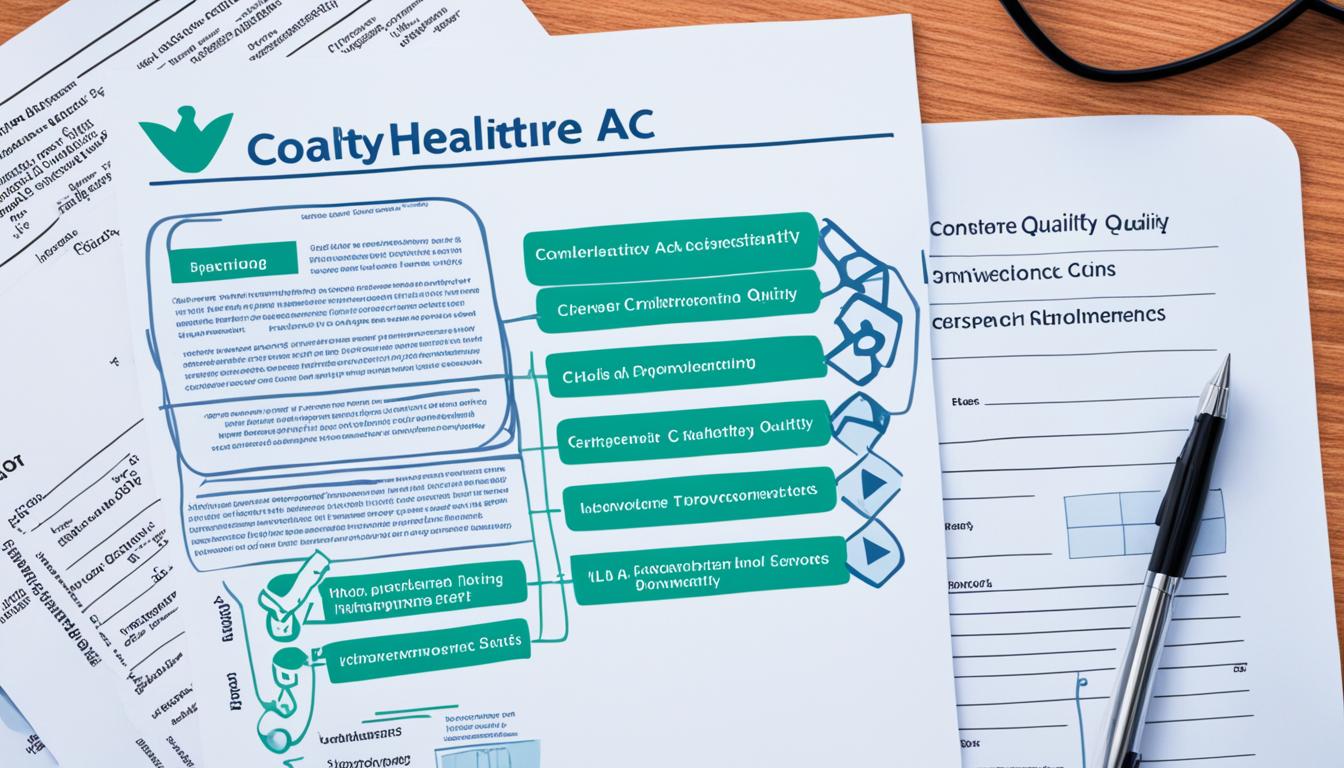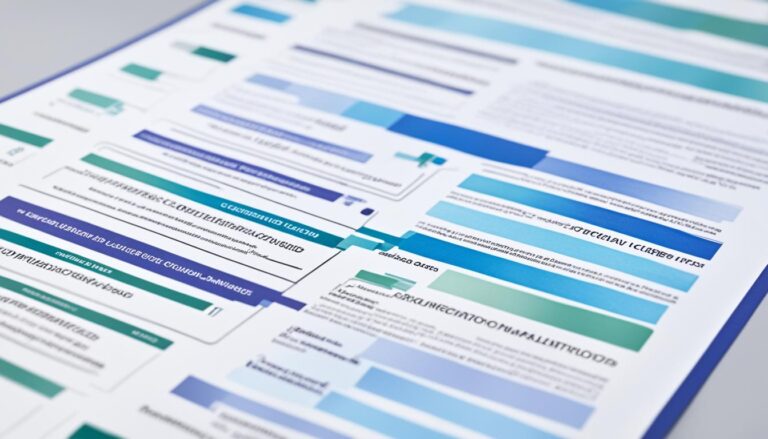HCQIA Guide: Elevate Healthcare Quality Standards
Did you know medical mistakes are the third leading cause of death in the U.S.? This shocking fact shows how crucial high healthcare quality standards are. The Healthcare Quality Improvement Act (HCQIA), passed in 1986, has helped improve healthcare quality and patient safety. It supports professional peer review and aims to decrease medical errors, offering legal protection to healthcare professionals during peer review.
This act also makes sure there is accountability. We’ll see how the Healthcare Quality Improvement Act has changed healthcare. And how following its rules can make health services better and safer for everyone in the country.
The HCQIA is significant legislation that has guided the U.S. towards better healthcare quality. It affects more than just hospitals; it’s part of the entire healthcare system. In this guide, we’ll uncover the HCQIA’s impact. We’ll show you how it not only acts as a legal guide but also points the way to safer, quality healthcare.
Key Takeaways
- Understanding the HCQIA is essential for improving patient outcomes and reducing medical errors.
- Compliance with HCQIA regulations is key to providing high-quality healthcare services.
- The Act encourages transparency and accountability within healthcare facilities.
- Peer review protection under HCQIA fosters a safer environment for patient care.
- HCQIA compliance impacts patient trust and healthcare quality assurance.
- Thorough exploration of HCQIA will empower healthcare professionals and organizations to uphold and surpass standards in patient care.
Introduction to the Healthcare Quality Improvement Act (HCQIA)
The Healthcare Quality Improvement Act (HCQIA) was made to better healthcare quality in the United States. It protects professionals who review each other’s work. This help improves patient care and safety.
HCQIA came about because of worries about medical mistakes. It created a way to check on healthcare quality. This act makes sure professionals can give honest feedback without fear of legal trouble.
HCQIA fundamentally underscores the doctrine that maintaining high standards of patient care and reducing the risk of malpractice necessitate a protected environment for healthcare practitioners to evaluate one another’s work candidly and constructively.
HCQIA supports peer review and oversight in healthcare:
- Peer Review Committees – Groups within healthcare organizations that check on doctors’ work.
- Professional Conduct and Competence – Making sure care and practice meet high standards.
- Sanctions and Reporting – Punishing those who don’t meet the standards and reporting to the NPDB.
HCQIA’s influence goes beyond procedures. It creates a place where improving healthcare quality is a constant goal. Here’s how it affects different areas:
| Area of Impact | HCQIA Influence |
|---|---|
| Legal Protection for Peer Review | Gives legal safety to those in the peer review process, if they follow HCQIA standards. |
| Professional Accountability | Pushes healthcare workers to keep each other at high standards, improving care. |
| Data Bank Reporting | Makes sure reports on conduct and decisions are shared nationwide. |
| Quality Care Incentivization | Encourages excellent care and deters bad practices. |
As healthcare gets more advanced, HCQIA is key in improving quality. It is vital for safer patient care and high healthcare standards.
Understanding HCQIA Regulations and Their Importance
The Health Care Quality Improvement Act (HCQIA) is key for better healthcare. It makes sure hospitals offer top-notch care. This is what patients and workers look for.
The Role of HCQIA in Healthcare Quality Assurance
HCQIA rules play a big part in delivering great healthcare. They make hospitals check how well their doctors are doing. This way, everyone stays safe and everything is clear.
Compliance with HCQIA for Healthcare Facilities
For hospitals, following HCQIA compliance is a must. They have to stick to many rules to show they’re doing a good job.
| HCQIA Compliance Aspect | Details | Impact on Healthcare Facilities |
|---|---|---|
| Peer Review | Regular assessments of medical practitioners to maintain high healthcare standards. | Enhanced patient trust and improved healthcare outcomes. |
| Professional Conduct | Monitoring the behavior and ethics of healthcare professionals. | A robust reputation for the facility and increased community confidence. |
| Reporting Obligations | Mandatory disclosure of any inconsistencies in patient care or facility operations. | Contribution to a national benchmarking system that underpins quality improvement. |
Meeting HCQIA standards shows a hospital’s dedication to top care. By sticking to these rules, they lead in offering quality healthcare.
The Impact of Healthcare Compliance on Patient Trust
The foundation of a great healthcare system is patient trust. This trust comes from healthcare compliance. When patients believe in their healthcare providers’ commitment to rules, they take an active role in their health. This leads to better results. But, ignoring these rules can harm trust, hurting both relationships with patients and the facility’s name.
Good healthcare compliance means sticking to ethics, laws, and quality. This makes a place where patient safety and health are top priorities. Below is a chart showing how compliance affects patient trust.
| Compliance Area | Impact on Patient Trust |
|---|---|
| Protection of Patient Data | Increases confidence in privacy and confidentiality |
| Adherence to Treatment Protocols | Enhances belief in the reliability and quality of care |
| Regular Staff Training | Encourages trust in the competence of healthcare professionals |
| Transparent Communication | Builds stronger, more honest patient-provider relationships |
| Accountability Measures | Fosters respect and reassurance in the system’s checks and balances |
“When patients see that a hospital takes healthcare compliance seriously, their trust grows. They feel assured that their care is in good hands.”
This quote shows how important healthcare compliance is for maintaining patient trust.
- Audits and checks on how well rules are followed help patients think better of the care they receive.
- When rules are not followed, it can lead to big problems that make patients worry.
- Working closely with groups that set rules keeps healthcare at the top in taking care of patients.
So, healthcare groups should see compliance as a key part of caring for patients. By doing this, they make a place of trust for everyone who comes for care.
Exploring the Peer Review Process in Healthcare Under HCQIA
The peer review process is key in healthcare, guided by the Healthcare Quality Improvement Act (HCQIA). This process provides vital oversight to keep medical care standards high. It acts as a shield, making sure healthcare providers aim to improve their work. This leads to effective peer reviews, promoting excellence and responsibility.
Benefits of Effective Peer Reviews
Effective peer reviews bring many positives for patients and healthcare workers. By looking closely at how care is given, they point out what can be better. This improves patient care. Here, we’ll look at how this important process helps:
- Improvement of Clinical Skills and Knowledge
- Reduction of Medical Errors and Enhancement of Patient Safety
- Encouragement of Professional Development and Feedback Culture
- Validation of Clinical Practices Against Established Standards
Guidelines for Conducting Peer Reviews
Following guidelines for peer reviews ensures the process works well. The points below are key for reviews that meet HCQIA standards:
- Establish Clear Review Objectives Tailored to Specific Clinical Scenarios
- Engage Diverse, Unbiased Reviewers to Promote Fair Assessment
- Use Standardized Review Tools and Metrics for Consistency
- Maintain Confidentiality Throughout the Review Process
- Provide Constructive Feedback That Encourages Improvement
By using these best practices in the peer review process, healthcare facilities not only meet HCQIA rules. They also lift the quality of care and make patients happier.
Key Elements of Medical Staff Credentialing through HCQIA
Medical staff credentialing is key in keeping healthcare quality high. HCQIA sets the standards for this. It checks the skills and backgrounds of healthcare workers.
HCQIA credentialing aims to make sure patients are safe. It requires that medical staff meet strict standards. It also includes regular checks on how healthcare professionals perform. This helps the medical field stay up-to-date.
- Verification of Educational Background
- Review of Licensure and any Specialty Certifications
- Evaluation of Work History and Clinical Experience
- Assessment of Peer References and Recommendations
The table below shows what HCQIA asks for from healthcare workers. It shows how serious the process is:
| Credentialing Criteria | Purpose | Verification Method |
|---|---|---|
| Educational Accreditation | To ensure the legitimacy of the professional’s foundational knowledge and training. | Reviewing diplomas and transcripts from accredited institutions. |
| Board Certification | To confirm specialization within a medical field and ongoing commitment to industry excellence. | Validating certificates from official medical boards. |
| Licensing | To legally permit the individual to practice medicine within a certain jurisdiction. | Checking active licenses with state’s medical licensing boards. |
| Work History | To assess experience and professional conduct in real-world settings. | Examining previous employment records and roles. |
| Peer Review | To gain insights into the professional’s competence and ethical practice from colleagues. | Collecting and evaluating peer evaluations and references. |
Medical staff credentialing by HCQIA is ongoing. It adapts to changes in the medical world. This makes sure that patient care stays top-notch.
In closing, HCQIA helps maintain high healthcare standards. It focuses on patient safety and quality care. This benefits everyone in healthcare.
How HCQIA Enhances Quality Improvement in Healthcare
The Healthcare Quality Improvement Act (HCQIA) is key for better patient care. It gives a framework that health organizations can follow to improve. This act focuses on being accountable, ensuring doctors are skilled, and being open in operations. This leads to meeting and often surpassing quality standards.
Healthcare Performance Improvement Strategies
Healthcare performance improvement strategies are vital for better care quality. They include making processes better, improving patient safety, and training staff continuously. Using proven practices and giving staff learning chances are essential. These steps meet HCQIA’s guidelines.
Good communication and checking performance regularly are also important. This helps find areas that need quick improvement. It makes sure actions taken are in line with HCQIA’s goals.
Case Studies: Successes in Quality Enhancement
Many case studies show how HCQIA has changed healthcare. They tell how different places have used HCQIA’s standards. This has led to better service and happier patients.
| Healthcare Organization | Challenges | Implemented Strategies | Results |
|---|---|---|---|
| Community Hospital X | Lengthy patient wait times and high readmission rates | Process re-engineering and staff training programs | 35% reduction in wait times and 20% decrease in 30-day readmissions |
| Rural Clinic Y | Limited access to specialist care and resources | Telehealth services expansion and partnership with local specialists | Enhanced care availability and patient access to specialist consultations |
| Urban Medical Center Z | Suboptimal care coordination and patient flow | Implementation of an electronic health record system and cross-departmental training | Streamlined operations and improved interdisciplinary communication |
These reports prove HCQIA works well. They show a way forward for others wanting to do well. By following HCQIA-guided initiatives, healthcare providers can aim for excellence. This doesn’t just follow legal rules but truly betters patient care.
Navigating HCQIA Reporting Requirements and Compliance
Understanding the HCQIA reporting requirements is crucial for the quality of healthcare services. It’s vital for facilities to follow these procedures closely. This ensures safety for patients and the quality of care they receive.
Healthcare providers need to report specific events to meet HCQIA standards. This includes actions that harm or could harm a patient’s health. It also covers changes to a healthcare professional’s clinical privileges if they last more than 30 days.
When it comes to timelines for reporting, reports must be prompt. Facilities should report within 15 days after a decision that affects a professional’s privileges due to timeline issues.
- Any resignation from medical staff during an investigation must be reported immediately.
- If someone is terminated due to performance issues, it must be reported.
- Reports to the National Practitioner Data Bank are required within 30 days after a final decision.
Non-compliance with HCQIA reporting requirements leads to severe consequences. This includes losing immunity from legal penalties and being excluded from Medicare and Medicaid. Providers must be aware and careful to follow these rules.
Not following HCQIA reporting standards can have serious legal and reputational damages. Compliance is essential, not just for regulations, but also for ethical reasons.
For effective compliance, healthcare organizations should have clear reporting systems. They should train their staff regularly and review policies with HCQIA guidelines in mind. Having a good tracking and reporting system helps maintain quality and safety in healthcare.
Best Practices for Healthcare Quality Assurance Programs
Healthcare quality assurance programs are key to high patient care standards. They combine strategies and technology, helping healthcare places handle patient safety and care quality.
Developing a Culture of Compliance within Healthcare Organizations
Building a culture of compliance is crucial for improving healthcare quality. It ensures everyone, from top managers to staff, follows healthcare rules and ethics. This creates a workplace where following policies is important, people are rewarded, and everyone helps to make care better.
Technology’s Role in Optimizing Quality Assurance
Technology has changed how healthcare centers manage data, check on care, and look at outcomes. With digital tools, professionals can act fast on issues. This includes using electronic health records and monitoring systems for better quality assurance.
| Compliance Element | Traditional Approach | Technology-Enhanced Approach |
|---|---|---|
| Patient Data Management | Manual record keeping | Use of Electronic Health Records (EHR) |
| Performance Monitoring | Periodic audits | Continuous monitoring with digital tools |
| Quality Improvement | Reactive individual case reviews | Proactive analysis with predictive analytics |
| Risk Management | Ad hoc risk assessment | Integrated risk management systems |
| Compliance Training | In-person workshops and seminars | Online education platforms and simulations |
Addressing Non-Compliance: Pitfalls and Preventative Measures
The healthcare world closely follows rules to protect patients and uphold medical service quality. First, it’s key to know the dangers of healthcare non-compliance and how to stop them. The effects of not following rules can damage reputations, lead to fines, and put patients at risk.
We need to look at the usual pitfalls and steps to stay within healthcare standards:
- Identifying the Gaps: Sometimes, healthcare groups miss flaws in their systems. Regular checks help find and fix these issues early.
- Ongoing Education: Not knowing the rules can cause problems. Training helps create a workplace focused on following guidelines.
- Technology Integration: Strong IT in healthcare helps keep things in line. Tools like EHRs can spot issues automatically, reducing mistakes and rule-breaking.
- Transparent Reporting Processes: A clear system for reporting issues lets staff address problems quickly. This approach makes sure employees can flag concerns safely.
To effectively prevent non-compliance, leaders must commit to high standards. They should build a place where good care and patient safety are most important. This is the best way for healthcare groups to steer clear of non-compliance risks and focus on top-notch care.
The Evolving Landscape of Healthcare Performance Improvement
The world of healthcare is changing fast. This makes healthcare performance improvement very important. With new technology and what patients expect, healthcare places face many new challenges and chances.
Healthcare has to adapt fast. Providers must find new ways to improve how they care for patients and run their operations. They are always looking for new trends that can change how they treat patients.
- Integration of Artificial Intelligence and Machine Learning
- Emphasizing Patient-Centric Care Models
- Adoption of Telehealth and Remote Monitoring
- Advancing Interoperability Between Systems
- Embracing Predictive Analytics for Healthcare Outcomes
To start these projects, healthcare groups need a careful plan. They must think about how each trend could change their work and affect patient health.
With all the changes, it’s key for places to look at how they’re doing. They should ask if their plans work well and if they meet the needs of patients and staff.
| Performance Area | Current Benchmark | Emerging Trend | Future Goal |
|---|---|---|---|
| Patient Satisfaction | Traditional Surveys | Real-Time Feedback Systems | Personalized Patient Experiences |
| Clinical Outcomes | Aggregate Data Review | Individual Health Tracking | Precise Intervention Strategies |
| Operational Efficiency | Annual Performance Reports | Continuous Process Improvement | Lean Management Techniques |
The path to better healthcare performance improvement in a changing world is not easy. It needs a promise to always learn, to use new plans, and to think of new ideas. This approach helps to not only keep up but also to lead in healthcare quality.
Trends and Opportunities Shaping HCQIA Compliance
The healthcare quality improvement scene is always changing. At its heart is HCQIA compliance. As we look into this area, two major trends stand out. These are the use of digital health records and the vital need for education and training in HCQIA.
Advent of Digital Health Records and Impact on Compliance
Moving to digital health records marks a big step for healthcare compliance. These systems make it easier to manage patient data. This leads to better HCQIA compliance. With all health information in one place, it’s easier to check compliance and quickly fix any issues.
Yet, switching to digital records also brings challenges. Data security and patient privacy are big concerns. Healthcare groups must deal with these issues to make the most of digital systems. They must do this while protecting patient info, following HCQIA rules.
Education and Training to Uphold HCQIA Standards
With new tech comes the need for ongoing education and training. It’s crucial for keeping up with HCQIA compliance. Continuous education and training in HCQIA make sure healthcare workers know the latest rules and best practices. Good training helps staff use digital health records well and keep patients safe.
Creating a learning and compliance culture is key for healthcare places. It helps them meet HCQIA standards now and get ready for future changes. This prepares them for changes in healthcare quality and compliance.
In sum, digital health records and constant learning are reshaping HCQIA compliance. Welcoming these changes helps healthcare providers give better quality care. They can meet compliance demands and offer excellent patient care.
Conclusion
We’re finishing our deep dive into the Healthcare Quality Improvement Act (HCQIA). Let’s remember why this law is so vital. It aims to boost healthcare standards. Through this exploration, we’ve seen how HCQIA helps keep patients safe. It also promotes better healthcare quality and sets up accountability in medical facilities.
HCQIA guides us towards better healthcare. The peer review, credentialing, and quality programs we discussed are key to this. They’re not just rules to follow. They’re steps towards better care for patients. Providers should see improving quality as essential. Following HCQIA means better care for everyone.
In the end, HCQIA lays a foundation for making patient care better. It challenges healthcare leaders to include these rules in their work. HCQIA should inspire us all to work on improving healthcare quality. Let’s all work together to make care better, by always looking for ways to enhance, examine, and refine how we take care of patients.







